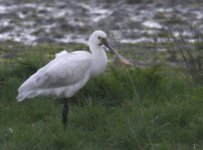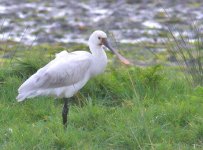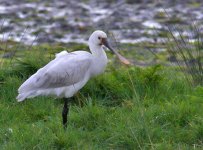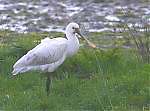In tricky, high-contrast lighting situations, it can be a good idea to take your exposure reading from a "neutral" area of the scene (eg grass) and either lock that exposure, if your camera has that feature, or else set it manually. It's also worth bracketing exposures. Some cameras allow this feature to be set automatically. If yours doesn't, you would have to take shots at, say, -? and -½ EV then +? and +½. Of course, this presupposes the bird stays around long enough for you to do so!!
With a big white bird like the spoonbill, you have to guard against burning out feather detail in the highlights. In the "improved" examples of your pic, you can see this starting to happen in the versions posted by myself and TheRaptor because we've brightened the whole image. Rob's version has avoided this, but at the cost of remaining slightly underexposed. Which just goes to show how important it is to try and get the exposure right. There is a limit to what can be done afterwards, especially if you don't want your pic to have that "over processed" look.
Malcolm







